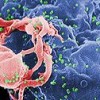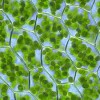DNA From The Beginning

HIV Vaccine?
Jul 14th
We are in the midst of a media explosion surrounding the possibility of a vaccine for HIV. For years this has seemed a hopeless situation, so a great deal of effort and money has been spent on the campaign to educate people about transmission and prevent infection. Unfortunately, according to recent reports (http://www.mg.co.za/article/2010-07-12-hiv-vaccine-the-only-real-answer), the number of new infections is still an alarming 7400 per day! In addition, less than half of the 9.5 million people in low-middle income households infected with HIV have access to anti viral treatments.
These staggering statistics demonstrate very clearly that efforts to help infected individuals are available More >

Neandertal DNA and Proteins
May 19th
With the completion of the Neandertal genome by the team of Dr. Svante Paabo and a closer look at their proteins by Gregory Hannon’s team at CSHL, scientists reveal incredible similarities between Neandertals and humans.
Neandertals, the extinct species of what are most likely our closest relatives, lived on earth at the same time as our human ancestors but died out about 30,000 years ago. With the sequence of their genome now complete, we can compare the DNA to humans and chimpanzees to learn more about what makes humans unique as a species.
The discovery of fossils is an exciting link to More >

Cilantrophobia
Apr 14th
Growing up I was a very picky eater. When I didn’t like what my mother had prepared for dinner, I would usually just say, “I’m not hungry” and make myself a peanut butter sandwich. As a grown up, my food choices have changed a great deal, in fact, I enjoy trying new things and watching to Food Network for good ideas.
One of the cooking tips that I have picked up from all of the foodie shows I watch is to use fresh herbs, whenever possible. Believe it or not, that green spring of parsley on my plate at restaurants that More >

Possible Future Treatment for Type 1 Diabetes
Apr 5th
Insulin, a hormone produced by the pancreas, signals cells to remove glucose from the blood and store it as glycogen. Glucagon is a protein also produced by cells in the pancreas but it has the opposite effect of insulin. When blood glucose levels are low, glucagon causes the breakdown of glycogen into glucose that is then released into the blood. The insulin is made in beta cells, where as the glucagon is made in alpha cells. In patients with type 1 diabetes, the immune system attacks the beta cells, eliminating insulin production.
Scientists from the University of Geneva have shown that More >

Viral Influence
Mar 17th

Amazing Microbes
Mar 16th
Most people associate microorganisms, such as bacteria fungi and protists, with little more than making people sick. While some can create serious problems for us, these amazing creatures deserve more positive attention for their role in how life works. In fact, the number of bacteria cells in and on your body is greater than the number of your own cells. Some of the bacteria, including a type of E.coli in our digestive system, help us by producing vitamins and controlling levels of potentially harmful strains.
The recent sequencing of the panda genome has provided even greater insight into the significance of More >

Genes Don’t Exist to Cause Disease
Feb 17th
It is not uncommon during labs on mutations, to discuss that mutations can cause genetic disease. Students will use the phrase “the gene for breast cancer” or “the gene for hemophilia” when these discussions take place. What many think, is that individuals with breast cancer or other genetic diseases have a gene that others do not. In reality, they have a gene that everyone has, but the gene has a mutation that affects its function. Genes don’t exist to cause disease. This is a recurrent theme for me!
For example, when someone has hemophilia (a blood clotting disorder), there is a More >

Genetics and Behavior
Feb 8th
Genetics plays a greater role in our lives than many of us realize. While certain behaviors seem obviously connected to a need for survival, many behaviors are linked to genes in ways we do not yet understand. So, to what extent do our genes dictate our behaviors?
One example of controlled behaviors has stirred up a variety of questions. A species of fungus, Ophiocordyceps unilateralis, infects a type of carpenter ant. What is unusual about the infection is that the fungus somehow directs the ant to move to a location on the leaves of the trees normally inhabited by the ants. More >

Gene Theft and Green People?
Jan 21st
I have been asked several times by middle school students if it would be possible to give humans the genes to carry out photosynthesis. It’s been theorized by a few of these students that this would solve some major nutrition problems in places currently plagued with drought. I always smile and agree that is sounds like a great idea, but probably not possible. Now, there is actually some evidence to the contrary.
A sea slug species, Elysia chlorotica, found in the marshes of New England and Canada has a unique trait. It produces chlorophyll and can use photosynthesis to make it’s own food – just like a More >

Staying Positive in the Classroom
Jan 6th
I normally approach each lesson as though I am about to perform on stage. If I am feeling agitated or unhappy I force myself to push aside those feelings and show my excitement about the topic we are about to discuss. I have noticed that lately I have been stuck in a state of boredom when it comes to teaching. I have tried various tricks to get myself out of the rut. Thinking about the needs of the students and why I love teaching seems to help me the most.
I have to remind myself that the students I work with have a lot More >
